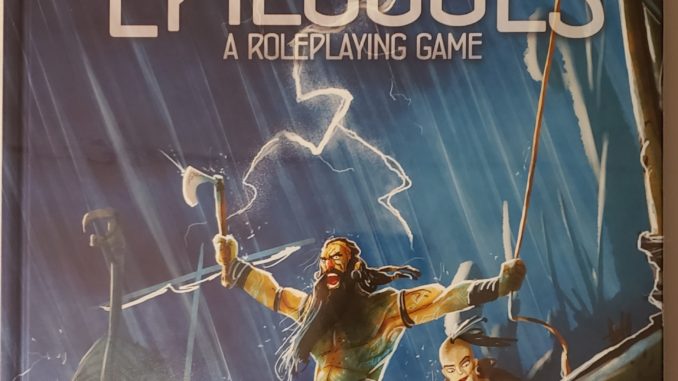
The North Sea Saga board games come to tabletop RPG with The North Sea Epilogues.
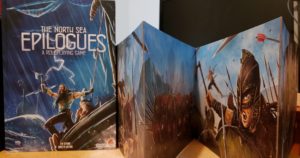
At Origins Game Fair 2019, Renegade Game Studios presented me with a copy of their (at the time) soon-to-be-released The North Sea Epilogues: A Roleplaying Game hardcover. Funded via Kickstarter, this tabletop RPG is based on Renegade Game’s popular board game series, The North Sea Saga. As with those board games, this RPG is set during the Viking Age as you play a shield maiden or a Northmen trying to make the gods remember your name.
What is this?
The North Sea Epilogues: A Roleplaying Game by Tim and Kristin Devine is derived from the three main board games in The North Sea Saga series, all by Shem Phillips, Shipwrights of the North Sea, Raiders of the North Sea, and Explorers of the North Sea. Both lines are about Vikings, share the same setting, and make use of artwork by Mihajlo Dimitrievsk. Yet, each differs in specific focus and gameplay.
The board games cover several periods within the Viking Age as they delve into aspects of being a Viking with gameplay ranging from building ships to raiding to exploring and colonizing. The RPG digs in deeper, dialing into the fantastic day-to-day of the Vikings as your signature Viking strives to make their way in a harsh world. Rules light and tattooed in stylized art, this RPG offers a sanitized vision of the Vikings that focuses less on the lawlessness of their behavior and more on the romanticized notions of what they were.
Gameplay
To start the game, players (or the GM) create the clan – moniker, history, symbol, conflicts, allies, and enemies – their characters hail from. This gives your table a great deal of say on the atmosphere of the world you’ll play in. Is your tribe prosperous? Mercenaries? Farmers? Sailors? Happy with their jarl (leader)? This option gives the players the chance to leave their fingerprints on the setting.
Your vehicle for the game, your character, is more flavor than crunchy stats. Starting at character creation, many of the developments are generated through descriptions and questions instead of hard numeric values. You begin with your name and appearance before choosing a Path (class). While in many RPGs the class would carry a great deal of weight for the game, this RPG is narrative with limited mechanical differences between, say, the Path of the Berserker and the Path of the Healer. In D&D, one would be the frontline of combat while the other would be the ambulance. Here, either could charge through the door first. If your character follows the Path of the Healer then their Path perk is the ability, during downtime, to heal two injuries instead of one. Since it is used during downtime to double healing instead of used in combat, it’s not a game changer. For the Berserker, they are more likely to get a lower Difficulty Level (DL) to hit an enemy. That’s nice in the sense that you may want to play your Path of the Skald (bard) character as a true warrior-poet of great martial deeds who writes their own gushing ballads.
After the Path is selected, it’s a series of choices to determine your character’s motivations, traits, and flaws. These are mostly for roleplaying purposes but can enter into the gears of the system at critical points. Finally, you get to the stats. They’re divided into 4 attributes with 5 associated skills per attribute. You put points into each attribute and each skill, then add them together to get your bonus to the d20 roll. Among the 20 skills, one will be your specialty meaning you’ll roll 2d20 and take the higher result for that skill. Finally, you calculate your Strain threshold (read: max HP, broadly) and Grit (read: Fate Points, loosely).
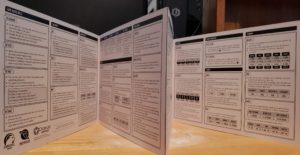
This is a rules light product that only needs 2d20s. Don’t read “rules light” as without degrees of calculation or resource management. This engine is a clever system that requires you to marshal your descriptions and in-game resource (Grit) to overcome challenges.
For every challenge, whether combat, physical, mental, or spiritual, the GM sets a Difficulty Level (DL) and a Target Number. Don’t assume, like I did, that the Target Number is the number you need to roll to achieve an outcome. Take a beat because, in this game, the number you need to roll to achieve an outcome is the Difficulty Level. The Target Number is closer to monster Hit Points in D&D, though situations can have a Target Number. Here’s where the rules light aspect of the game has some teeth and calculations. The DL is not a static, known affair and, starting out, it may be set at such a level that no matter how well you roll, you cannot achieve it without spending resources and assistance.
For skill checks, including combat, you narrate your approach (to justify the skill you plan to use) and roll a d20 (2d20 if that skill is your specialty) and add your skill total (0 to 5 with a low level character). Compare the result to the Difficulty Level the GM selected from Minor (2-4) to “Impossible” (30+) with groupings between. A natural one produces a complication, a natural twenty removes a complication.
For the GM, combat is easy to game. You set the DL and Target Number of the enemy/challenge then describe it. The PCs make all of the rolls and take Strains/Injuries when they fail rolls. Because the player’s results decide the enemy’s actions, the GM does not have to take time from the players to roll separate turns for the enemy. It’s possible that the PCs will overcome a challenge and take no Strain. It’s possible that the PCs will roll so poorly that they are overcome; it’s all on their dice, not the GM’s. After the results are announced and compared to the Difficulty Level, the GM declares if it was positive or negative and the player narrates the visuals of the event. It keeps the game moving and lets the GM focus on larger moments instead of minutia.
Reducing a challenge’s Difficulty Level is the key to this system. Unlike D&D where getting past the armor class by one pip or by ten makes no difference as you still go to the same damage dice regardless; this system rewards greater distance between the Difficulty Level and your result. If the DL is set to Daunting (15-19) and you get a 25 (Epic), the difference is three DLs and that results in your character inflicting more Targets (damage) and gaining Grit (a resource to spend to lower DLs or reduce Strain).
With more or less broad options that lack specific moves or mechanical differences in weapons, this is not a roll-for-every-possibility RPG. Actions can be talked through without the need for multiple dice rolls. It’s a better game for broad rolls that cover a swath of action.
The Setting
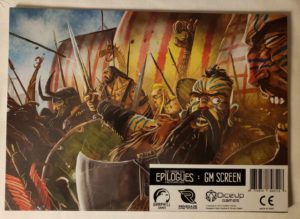 This is an RPG that could be both problematic and wonderful because it’s based on a version of historic Vikings. Problematic in that Vikings were a violent culture known for their brutality and abuses. Wonderful in their degree of social acceptance and the greater amount of equality certain women enjoyed compared to other historic cultures. This game embraces the forward-minded portions of historic Vikings while working to reduce the horrible details to a more PG-13 setting. It is not family oriented, but it hews closely enough to ensure it’s not outrageously Viking. That said, this is a game that might benefit from having the X-Card on deck – John Stavropoulos’ concept to address when the story gets out of hand and a player/GM wants to move on – in case any PC goes full Viking.
This is an RPG that could be both problematic and wonderful because it’s based on a version of historic Vikings. Problematic in that Vikings were a violent culture known for their brutality and abuses. Wonderful in their degree of social acceptance and the greater amount of equality certain women enjoyed compared to other historic cultures. This game embraces the forward-minded portions of historic Vikings while working to reduce the horrible details to a more PG-13 setting. It is not family oriented, but it hews closely enough to ensure it’s not outrageously Viking. That said, this is a game that might benefit from having the X-Card on deck – John Stavropoulos’ concept to address when the story gets out of hand and a player/GM wants to move on – in case any PC goes full Viking.
The hardcover is 123 pages plus a character sheet and the GM reference page. Rules run through page 47 while campaigns and adventures form the rest of the book. Adventures come from Shem Phillips of the board games, Banana Chan, Elizabeth Chaipraditkul, Jonathan Gilmour, and many more (17 adventures in total).
Beyond the core rulebook, there is The North Sea Epilogues: GM Screen. A four-panel affair in which each leaf measures at 8.5” by 12”, this product is an extremely useful reference for the GM. Many of the rules are given a solid overview via this screen. Save for a few minor ones, I found that I only needed the GM Screen and the GM Sheet to run the game. The only addition I would love for the GM Screen is a breakdown of the Difficulty Levels; they’re on the GM Sheet (the last page of the book, a handy reference sheet for encounters/challenges), but having that chart on the screen would be a nice addition.
Mihajlo Dimitrievski’s art is the centerpiece of these games. Energetic, stylized, bright, and evocative, this is the art that really defines the feel of this franchise. It’s Vikings o’ fun instead of Vikings o’ blood and death. Not to say you couldn’t go violent, but this does not have to be the darkest incarnation of the Northmen. 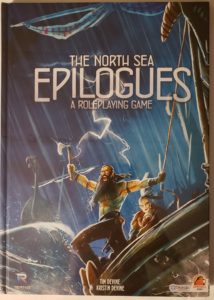
Who is this for?
If you’re fans of the board games and looking to expand on the experience, the RPG offers you another option to explore this world. A clever GM will build a large scale campaign around jumping from the RPG to nights of playing the board games, utilizing the board games as seasons within the life of their world. That’s the secret of this, you can enjoy the source material board games in conjunction with the RPG and that makes this RPG the best kind of adaptation.
Beyond the board gamer base, this is for any RPGer looking for a fun, rules light version of the world the Northmen conquered. The table-involving development of the clan and world prepares players to work together to lower each other’s DLs. As a GM, you can go hard on the players and still expect them to overcome, in part because they can’t die easily. While the GM still tells the tale, it’s flexible enough that working on the fly is possible. For the players, there’s both challenge and fun with nothing in the rules to prevent them from taking their character to the extreme so the gods know their name.
The North Sea Epilogues: A Roleplaying Game is available via Renegade Game Studios (here)
The North Sea Epilogues: A Roleplaying Game is available via DriveThruRPG (here)
Egg Embry participates in the OneBookShelf Affiliate Program. This program provides advertising fees by linking to DriveThruRPG.
Latest posts by Egg Embry (see all)
- New Gamemaster Month 2023 - January 20, 2023
